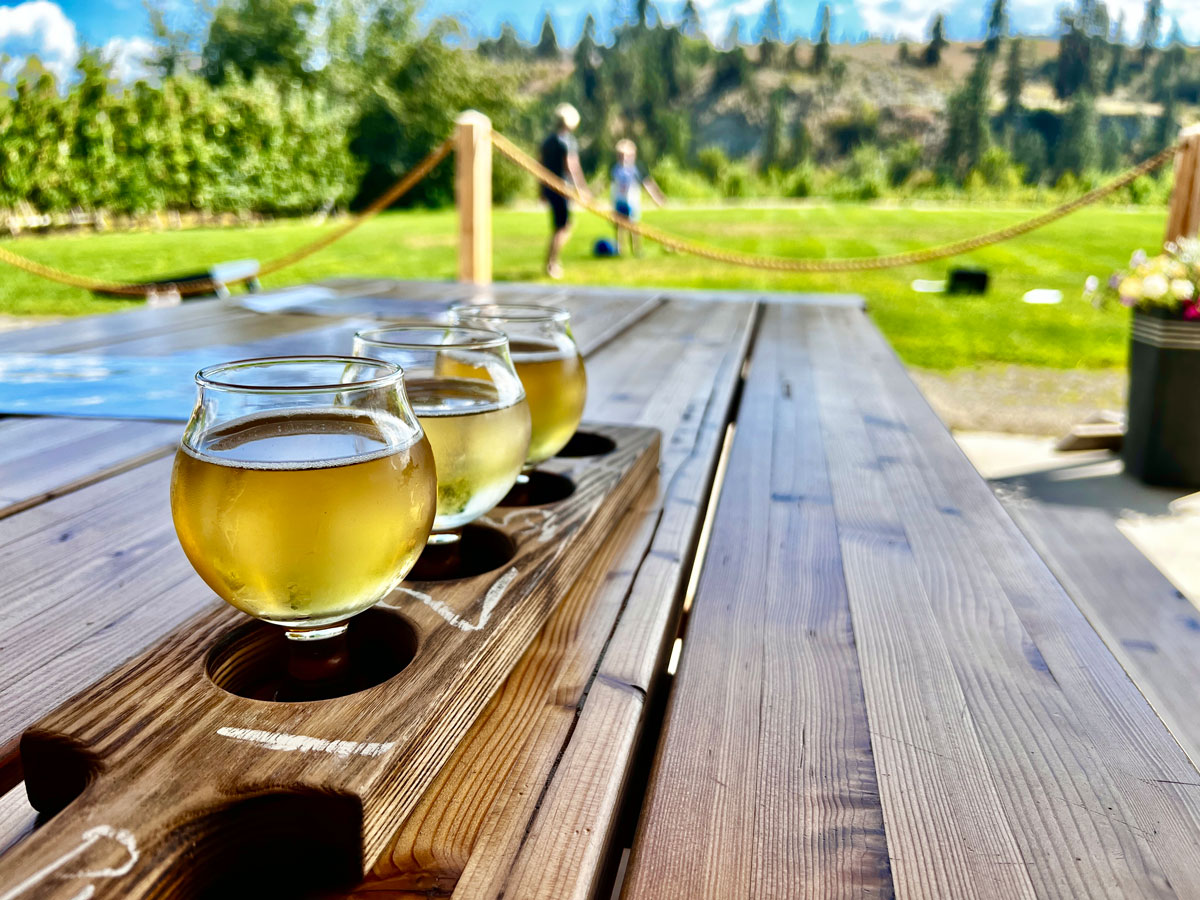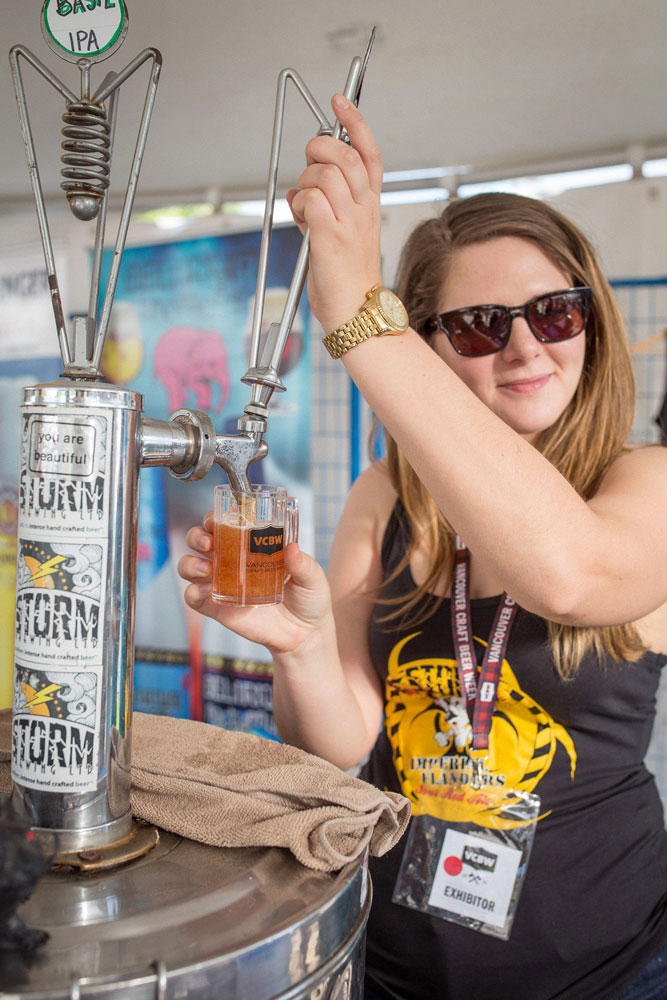Matt Cavers explores the Okanagan cider scene and discovers that maybe, just maybe, there can be too much of a good thing.

Back in July, I went to the Okanagan for a camping trip with my family, and I thought I’d visit a few cideries while I was out there and write a few words about them for this magazine. Seemed like a simple brief. But as soon as I arrived, I realized that it would be hard to convey just how much the Okanagan is.
Have you been there lately? Then maybe you know what it’s like. For me, it was hard to take it all in at first. One moment, we were driving through lonely ranch land on the way over from Keremeos, and the next, I was staring at a succession of oversaturated images: inner tubes on a canal; RVs packed side-by-side; a Mission Revival-style hotel with a sign reading “BIENVENIDOS BANDIDOS”; a billboard for a wine-tasting party bus promising a “last fling before the ring!” The Okanagan is party central.
But, more than that, for me, it’s the place that fruit comes from. I’m a cider maker at a Sunshine Coast cidery, and while we and our coastal colleagues grow what fruit we can in our own orchards, the West Coast climate, plus the fact that there just aren’t that many commercial orchards out this way, means we look to the Okanagan for most of our apples. And there they were—row after irrigated row of lush trees. Seeing this many apple trees in one place elevated my pulse a little.

En route to Summerland’s NOMAD Cider, we shared the winding rural road here and there with carefree-looking cyclists navigating the local wine-touring route. At one point the road crossed the otherwise-defunct Kettle Valley Railway and an actual steam train rolled by, the carriages laden with railway enthusiasts who, confusingly, waved at us as we waited at the crossing. That’s the Okanagan summer vibe, I guess—you’re so dazzled by the sun and the spectacle of it all that you feel moved to wave at randoms in a blue Mazda sedan.
NOMAD’s picnic area provided some shady respite. We settled at a table underneath the walnut trees and shared a flight, looking across to the rocky bluffs of Giant’s Head Mountain. It’s absurdly picturesque, and the cider is outstanding, particularly the rosé-coloured Geneva—a single-varietal cider made from the Geneva crabapple. NOMAD has earned a reputation for their single-varietal ciders. I’ve tried several, and they’re worth seeking out—cider is often made from a blend of apples and it’s fascinating to taste and smell how a Michelin differs from a Dabinett. But for me, sipping the Geneva in the picnic area, all I could think of was how strange and wonderful it must be to make cider right in the place where all this fruit grows—to seek out and obtain a whole tank’s worth of the same obscure apple variety from just down the road.

We finished our flight and headed off, dodging more cyclists, and eventually arrived at our second stop, Summerland Heritage Cider, a handsome, high-ceilinged barn between rows of apple trees. Sprinklers misted the orchard and the air, and everything looked intensely green, down to the manicured lawn, where my son immediately began playing with a set of giant Yahtzee dice.
Once again, each of the ciders on the flight was well-executed, especially Tuesday’s Original, a brilliantly balanced semi-dry cider made from a blend of dessert apples and tannic cider apples. While I sipped, I eavesdropped on the conversation taking place at the next table, where a bon viveur was recounting a restaurant meal gone wrong: “the saltiness of the Parmesan overwhelmed it,” he lamented. These were Okanagan problems, and he knew it, too, admitting a second later that “comparison is the thief of joy.” My joy was safe: everything I’d experienced in the Okanagan so far felt so surreal that no comparison felt possible.
Another flight finished, we headed off to our campsite on the side of Lake Okanagan. A day and several swims later, I resumed the mission, venturing past the country mansions of South Kelowna to visit Soma Cidery. “It’s great,” my friend Warren told me. “They have alpacas.”

And they did have alpacas. I took a selfie with one and we hummed greetings to each other. Nothing could surprise me anymore. But the cider beckoned, so I carried on across the manicured picnic area toward the main building. Constructed in a style that I’ll just irresponsibly name “Okanagan maximalism,” Soma is a picturesquely imposing concrete-and-wood edifice housing both a tasting room and a lounge. Inside, however, the staff were nothing but welcoming, and I toasted the alpacas with a tasting glass of their outstanding Hopped Apple Cider, all juice and summer sun and tropical fruit.
Everything about Soma and the other cideries we’d visited had been lovely. Everything was pretty and nothing was out of place. But—and I don’t know what this says about me—I was starting to feel unnerved by how nice everything was. Everywhere I looked could have been a backdrop for an engagement photoshoot. I needed an aesthetic palate cleanser. Also, we were getting hungry, so we turned around, leaving the pastoral landscape behind us, and pulled up to downtown Kelowna’s Jackknife Brewing, where the walls are plastered with pages from Heavy Metal magazine and the chalkboards are written in jagged, runic-looking letters. We ate a pizza called “The Crippler” and I drank a beer called “Judar’s Sword.” The guy seated at the next table was wearing a Brian Eno hat backwards. We were back in the world I knew. Beyond Jackknife’s patio there were rivers to float down on inflatable dinghies, peaches to buy from roadside stands, bon viveurs to eavesdrop on, and many more ciders to drink. Soon I’d be ready to head back out there, but I just needed another moment.




